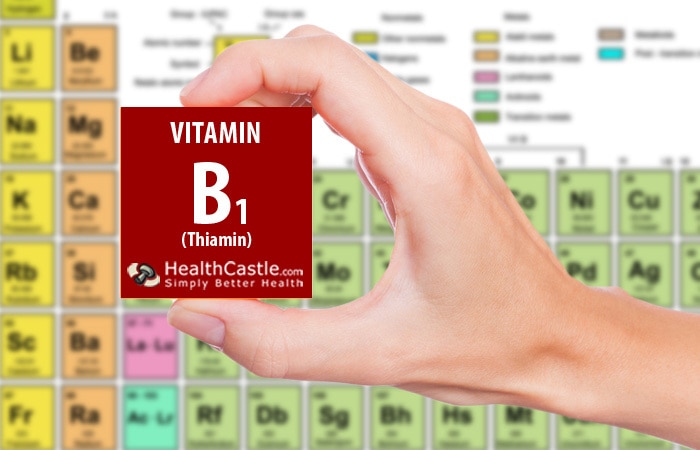
Written By: Carolyn Berry, RD
Title: Registered Dietitian
Alumni: University of British Columbia
Last Updated on:


Thiamin, also spelled thiamine and known as Vitamin B1, is one of eight B vitamins. All of the B vitamins are water soluble, meaning that the body does not store them but excretes them in the urine.
The Dietary Reference Intakes (DRI) for thiamin are shown below:
| Age Group | Recommended Dietary Allowance (RDA) per day | Tolerable Upper Intake (UI) Levels |
| Adults | ||
| 19 years and up | 1.2 mg men1.1 mg women | *No upper limit is established for this nutrient |
| Kids and Youth | ||
| 1 to 3 years | 0.5 mg | |
| 4 to 8 years | 0.6 mg | |
| 9 to 13 years | 0.9 mg | |
| 14 to 18 years | 1.2 mg boys1.0 mg girls | |
| Special Considerations | ||
| Pregnant women 14 years and up | 1.4 mg | |
| Lactating women 14 years and up | 1.4 mg |
Because thiamin is water soluble, excessive intake of thiamin-containing foods has not been shown to be toxic to humans.
Thiamin’s main role, like the other B vitamins, is to help your body use carbohydrates and protein to make energy. Your body needs it to form adenosine triphosphate (ATP), which every cell of the body uses for energy. It also assists in nervous system, heart, and muscle function. Thiamin is also used for digestive problems including poor appetite, ulcerative colitis, and ongoing diarrhea. Additionally, it is used to correct problems in people with certain types of genetic diseases.
Developing research shows that taking high doses of thiamin (100 mg three times daily) for three months may prevent kidney disease in people with type 2 diabetes. It does this by significantly decreasing the amount of albumin in the urine in people with type 2 diabetes, which is an indication of kidney damage. Developing research also shows that high doses of thiamin may help prevent cataracts.
Thiamin deficiency is uncommon, as most healthy people who eat a well-balanced diet get enough thiamin. However, alcoholics and people with Crohn’s disease or anorexia may be deficient. Thiamin deficiency causes a disease called beriberi.
The richest sources of thiamin include yeast extract, pork, fortified and enriched breakfast cereals and grain products, and meatless soy products.
| Food | Thiamin per serving |
| Yeast extract spread (Marmite or Vegemite), 2 tbsp | 3.6 mg |
| Bran flakes, 1 cup | 1.1 mg |
| Oatmeal, instant, cooked, 3/4 cup | 0.6-1.1 mg |
| Pork, various cuts, cooked, 3 oz | 0.48-1.2 mg |
| Sunflower seeds, shelled, 1/4 cup | 0.54 mg |
| Wheat germ, raw, 1/4 cup | 0.5 mg |
| Tuna, albacore/yellowfin, cooked, 3 oz | 0.43 mg |
| Tahini, 2 tbsp | 0.37 mg |
| Soy-based vegetarian meat, 3 oz | 0.36 mg |
| Navy beans, cooked, 3/4 cup | 0.32 mg |
| Edamame beans, cooked, 1/2 cup | 0.28 mg |
| Lentils, cooked, 3/4 cup | 0.25 mg |
In the United States: The daily value for thiamin is 1.5 mg, which is higher than the DRI for all age groups. The % daily value gives you an idea of how much thiamin is in the food you eat. However, the % daily value number is only required by the FDA for foods that have been fortified with thiamin.
The number you see on the Nutrition Facts label is a percentage calculated by dividing the amount of thiamin in one serving of the food by the daily value. For example, 1/4 cup of sunflower seeds that contains 0.54 mg of thiamin would have 36% of the daily value (DV) for thiamin.
In Canada: The daily value for thiamin is 1.3 mg. Listing the daily value for thiamin on the Nutrition Facts label is optional. However, products that have been enriched with thiamin, such as cereal and pasta, will most often have the daily value written on the label.
Alumni: University of British Columbia – Carolyn Berry is a Vancouver-based Registered Dietitian, self-proclaimed foodie, marathon runner, and owner of Berry Nourished. Carolyn works in a variety of areas including clinical nutrition, outpatient counselling at Medisys Preventive Health Clinic, as a nutrition tour leader with Save-On-Foods, and in the media, including segments on CBC Television, CKNW and Spice Radio. Through informative and practical nutrition advice and her food-first approach to health, Carolyn fulfills her passion to empower others with knowledge about nutrition so that they can make the best decisions to improve their health. She strongly believes that food should be both healthful and delicious.
micronutrient - vitamins, thiamin, vitamin b, vitamin b1, vitamins, vitamins - minerals